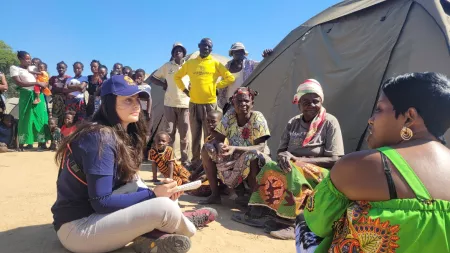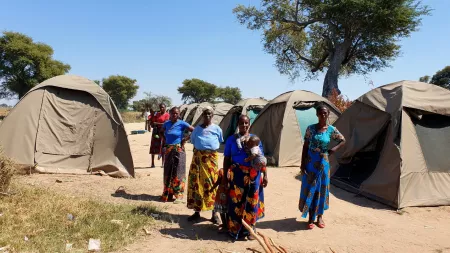The heat inside the tent shortly takes my breath away. I feel bad asking Cheelo to go inside to show me some of the items that she has. During the day she and her children do not stay inside the tent, because it is too hot to endure. Cheelo’s tent is one of many in this camp of internally displaced people in southern Zambia.
She lost her home a few months ago when flash floods ripped away her animals and everything she owns. She now lives here in this tent, together with another family. I ask her, how many people sleep in this tent. Thirteen. I look inside, trying to count how thirteen bodies might fit in this small space next to pots, sacks of maize meal, buckets, and jerricans.
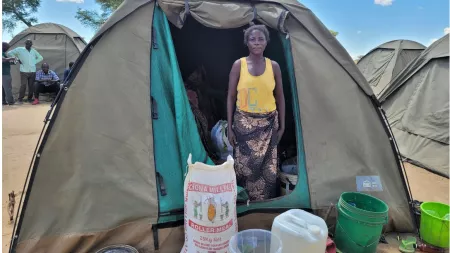
When I step back from the heat again and Cheelo is busily sorting through the items she wants to show me, I notice a woman standing next to the tent watching me work. She is an elderly woman with a walking stick that she heavily leans on. She smiles at me. Her name is Chuma and she is 85 years old. Later I learn that she lost her children and takes care of her small grandchildren alone. Now she also lost her home due to the floods and lives here in one of these too hot tents relying on neighbors and humanitarian assistance to feed herself and her grandchildren.
Whenever I visit a CARE project, I have a plan and usually know who I am going to talk to and inteview. But sometimes I deviate from the plan when I see people like Chuma. Because it is people like her that touch my heart in a special way. Every person has a different story to tell.
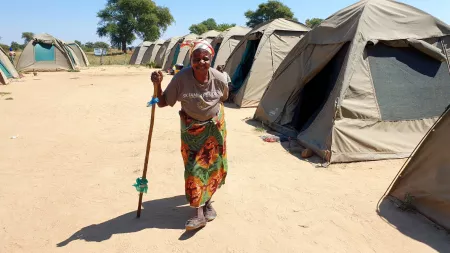
Every woman, man, child, mother, grandmother sitting in front of these tents watching and listening to what I am doing, have their own story. They lost their homes. They do not know when they will be able to return or how to repair their houses. One moment they live happily and independently with their families and animals, the next they sleep on the floor of a grey tent and do not know where to find enough food for each evening’s meal.
All are facing hardship and challenges, but at the same time, while I interview some of them, I also see how they manage. How a new routine starts to develop. How extraordinary humans can adapt to circumstances out of their control. Mothers walk long distances to fetch drinking water for their children. Older siblings cook maize over an open fire. Young children play the same games they played at home. Life goes on.
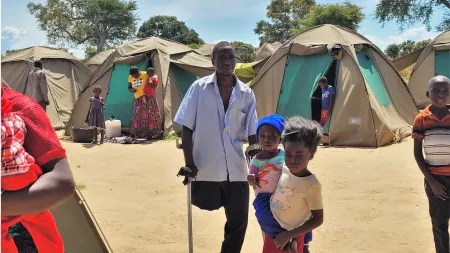
But then I see Chuma walking slowly but with purpose through the tents. I see a man on crutches because he only has one leg. I see people who already have a difficult life, struggling, and then a flood takes away their home and everything they own. Instead of enjoying her old age and relaxing in an armchair with her grandchildren playing around her, Chuma worries about where to find food for them. And I ask myself what do they do to survive?
It always takes my breath away to see the most vulnerable in emergencies. Every single person in this camp is struggling. They are displaced. They lost everything and had to start anew.
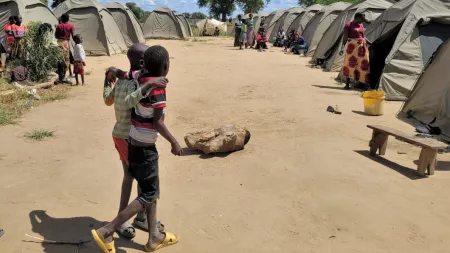
But they at least have the strength to go and fetch water and go looking for food. They still have their limbs to support their family. What do those that cannot walk do? Those that are too old, too weak, too sick?
Here in this camp, I receive an answer to this question: they help each other. The ones that have the strength to walk and carry things do this for the whole camp. They share their food. They cook for each other. They support each other. No one is forgotten. They have become a community. A big family. Children have become friends here. Mothers sit together and talk about the latest gossip. They survive all together.
How does CARE help?
CARE is providing emergency relief to people affected by the floods in Zambia. With cash, food, and non-food items such as blankets, solar lamps, water tanks, and buckets, CARE is helping displaced people who have no homes and few financial resources. In the long term, CARE’s projects focus on making people more resilient to climatic conditions, for example with reforestation projects, drought-resistant seeds, and training on nutrition and health.
